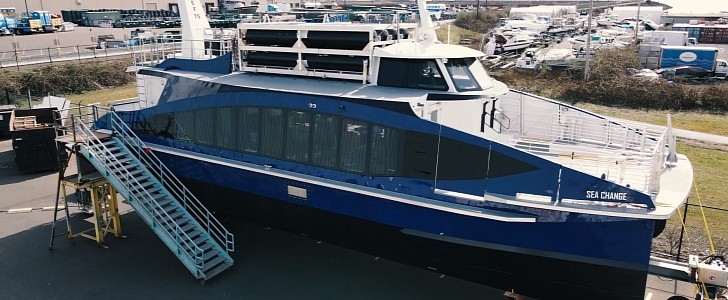Hydrogen fuel cell is significantly more energy-efficient than gasoline internal combustion engines, which is why more and more manufacturers look to this new technology to power their vehicles and reduce their carbon footprint. Switch Maritime makes its own switch to zero-carbon ships with its new Sea Change ferry, ready to launch in the San Francisco Bay in the third quarter of this year.
The company states that Sea Change is an important step in their shift away from carbon-intensive fossil fuel, which powers heavy polluting vehicles. Their new flagship is a passenger ferry and it i almost ready to start keeping crabon emissions at bay.
The aluminum catamaran ferry is 72 feet (21 meters) long and can hold 75 passengers. It is powered by two 300 kW electric motors, which are in turn powered by 360 kW of hydrogen fuel cells, combined with 100 kWh of lithium-ion battery storage, as explained on the company’s website. The Sea Change has a range of 300 nautical miles and a hydrogen tank of 246 kg (542 lb).
The maximum speed of the ferry is 20 knots (23 mph/37 kph), which guarantees a peaceful cruise, especially given that its cruising speed is even lower, at 16 knots (18.4 mph/29.6 kph). The speed of the catamaran will be boosted when needed with the help of the lithium battery pack.
The ferry is now 98 percent complete. The first unit will be put into commercial operation in the following months, in the San Francisco bay. But the company won’t stop there, as it plans to expand its fleet of zero-carbon ferries in other cities as well. Switch Maritime wants to build the first fleet of zero-emissions vessels in North America.
The Sea Change project started in 2016 and received $3 million in funding from the California Air Resources Board (CARB). Its construction began in Alameda, California, at Bay Ship and Yacht. It was later moved to Bellingham, Washington, where its hydrogen storage tanks and other equipment were installed.
The aluminum catamaran ferry is 72 feet (21 meters) long and can hold 75 passengers. It is powered by two 300 kW electric motors, which are in turn powered by 360 kW of hydrogen fuel cells, combined with 100 kWh of lithium-ion battery storage, as explained on the company’s website. The Sea Change has a range of 300 nautical miles and a hydrogen tank of 246 kg (542 lb).
The maximum speed of the ferry is 20 knots (23 mph/37 kph), which guarantees a peaceful cruise, especially given that its cruising speed is even lower, at 16 knots (18.4 mph/29.6 kph). The speed of the catamaran will be boosted when needed with the help of the lithium battery pack.
The ferry is now 98 percent complete. The first unit will be put into commercial operation in the following months, in the San Francisco bay. But the company won’t stop there, as it plans to expand its fleet of zero-carbon ferries in other cities as well. Switch Maritime wants to build the first fleet of zero-emissions vessels in North America.
The Sea Change project started in 2016 and received $3 million in funding from the California Air Resources Board (CARB). Its construction began in Alameda, California, at Bay Ship and Yacht. It was later moved to Bellingham, Washington, where its hydrogen storage tanks and other equipment were installed.

